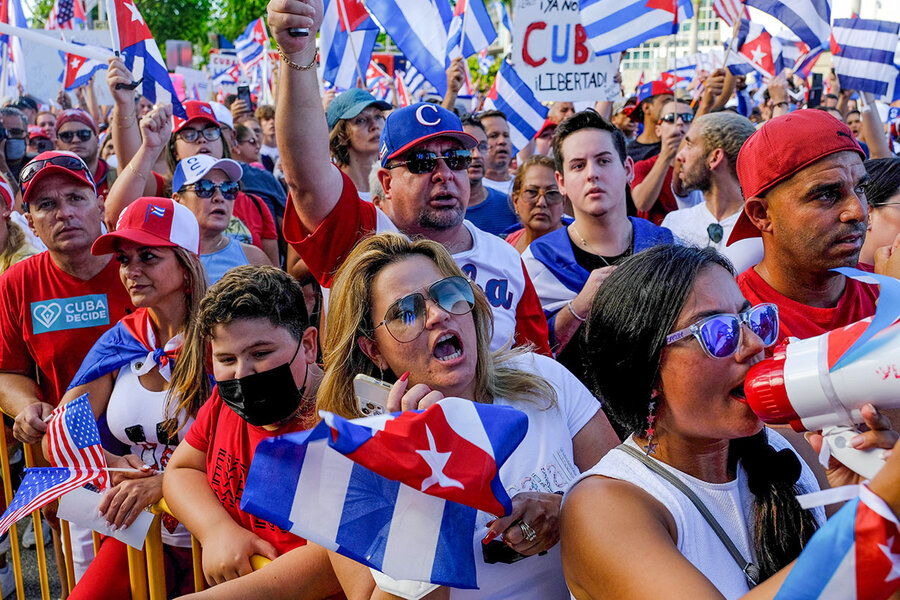Cuba News

As I’ve stated previously, I simply have trouble trusting any news coming out of the United States on Cuba, largely because it just reflects the hardened position of those who are reporting it. Left, liberal, or right, it usually just is talking points disguised as news. It’s pretty clear though that things are very bad in Cuba, that the government cannot and will not make necessary adjustments, and that people are really desperate. The Cuban government repression of the protests is both not surprising but also highly disappointing. Cuba is a messed up country. It’s not more messed up than Guatemala or Honduras or Nicaragua or Haiti or the Dominican Republic or many other Latin American nations. It’s just different messed up. But messed it it indeed is.
I tend to find NACLA one of the best sources of news on Latin America. It is certainly left-leaning and there are some bad articles and bad writers. But there are also some good articles and good writers. I thought this Ailynn Torres Santana piece was quite strong and balanced on the whole, one of the most reasonable thing I’ve read about Cuba in recent weeks.
Seen from Cuba—the Cuba both within and outside the island—the situation is more intense and complex. Our material, spiritual, political, and moral life depends on it. For the government, the protests were a mechanism of counterrevolutionary destabilization, led from the United States, that capitalized on “confused” people and manipulated discontent stemming from unmet needs. For some people, these days of protests were a mistake because they worsened the crisis in the country. Other diverse voices called for urgent—and improbable—humanitarian or military intervention to address medical and food shortages; these commentators, often weighing in from outside Cuba, held up the protests as the realization of their own aspirations. They don’t want dialogue with the government and, reaching ever-louder extremes, claim that it’s time to “kill the communists.” They make lists of “pro-government” figures, “disgusting communists,” and anyone who does not align with their political agendas.
For other people and groups, all intervention is unacceptable, and merely the suggestion of it is reprehensible. The anti-intervention camp has achieved a significant level of consensus, but it also contains differences within it. Part of this camp rejects the protests, viewing them as a threat that could spur the restoration of capitalism in the country. Another faction calls for listening to the people in the streets and starting a civic dialogue process. This group does not subscribe to the idea that the demonstrators are puppets of U.S. policy, but rather sees the protests as an expression of exhaustion on the part of at least some Cuban people due to: the impossibility of material survival; the accelerated shrinking of “equality zones,” particularly in terms of health services and supplies, that previously dulled Cuba’s successive crises beginning in the 1990s; absent or insufficient guarantees of rights to civil and political association, participation, and expression; absent or ineffective institutional responses to growing precarity; and the conviction that, if unchecked, this unsustainable situation will continue.
This sketch of different positions is not fixed nor final. There are other perspectives. And the sectors mentioned here sometimes fluctuate, overlap, and change quickly. Nevertheless, this gives a general sense of the landscape.
I definitely recommend reading the rest of this to get a sense of the landscape and not the utopian visions of the left or the revanchist visions of the right. The conclusion:
Although the protests sparked shock, political upheaval, and sadness, the protests were not the cause. A society does not break down with a social uprising. It goes the other way around. A social uprising occurs when society is already broken. It had already exploded, silently. No matter how carefully it is charted out, there will be no return to total “normality.” The protests did not end when people left the streets. Different sectors tested their strength in public space, and that experience will continue to be deeply processed at home, in neighborhoods, online, on the sidewalks, and in the body.
Crises solidify cracks, and the cracks show the losses. But the losses can also have transformative effects and produce reflections about the meaning of political community and about the awareness that my fate is inseparable from yours and that Cuba is only partly mine and ours because it also belongs to others. If the government resorts to old dogmas, it will effectively blow up bridges and make the political rage of at least a sector of the population unintelligible. More than ever, the question of what is good and just for Cuba is an open question. And now more than ever, the answers cannot be captured in a single still photo or tone of voice.


